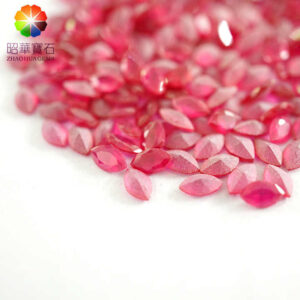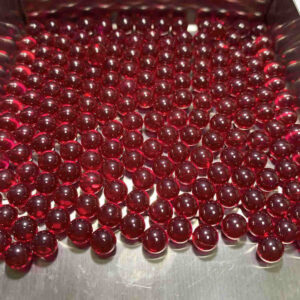In the world of gemstones, terms like Lab Ruby and Synthetic Ruby are often used interchangeably, yet many people wonder if there is any real difference between them. Are lab rubies the same as synthetic rubies? How do these compare to natural rubies? This article dives deep into these questions to clarify the facts and help consumers make informed decisions when buying ruby jewelry.
What Is a Lab Ruby?
A Lab Ruby, also known as a lab-grown ruby, is a ruby that is created in a controlled laboratory environment. Using advanced technology, these rubies are cultivated to have the same chemical composition, crystal structure, and physical properties as natural rubies found in the earth.
The process mimics natural formation but takes place in a matter of weeks or months instead of millions of years. This results in a gemstone that is physically and chemically identical to a natural ruby but produced through human intervention rather than geological processes.
What Is a Synthetic Ruby?
The term Synthetic Ruby technically refers to the exact same thing as a lab ruby. It is an artificial ruby created in a laboratory with the same fundamental properties as natural rubies. The word “synthetic” simply means “man-made” or “artificial,” but it does not imply that the gemstone is fake or imitation.
Historically, the term “synthetic” was widely used in scientific and commercial contexts. However, it sometimes carries a negative connotation among consumers who associate “synthetic” with “fake” or “low quality.” This perception has prompted many jewelers and marketers to prefer the term “lab-grown” or “lab-created” when describing these gems.
Lab Ruby vs Synthetic Ruby: Are They Different?
Scientifically and gemologically, there is no difference between lab rubies and synthetic rubies. Both terms describe rubies grown in a lab with identical chemical and physical properties as natural rubies. They:
- Contain aluminum oxide (Al2O3) with trace amounts of chromium, which gives the ruby its characteristic red color.
- Possess the same hardness, brilliance, and durability as natural rubies.
- Are verified as genuine rubies by gemological laboratories.
The difference lies mostly in marketing and consumer perception, with “lab ruby” sounding more modern and environmentally friendly, while “synthetic ruby” is a traditional term used since the early 1900s.
How Do Lab/Synthetic Rubies Compare to Natural Rubies?
Natural rubies are formed over millions of years through geological processes deep inside the earth. They are rare, and their value can be very high depending on size, color, and clarity.
Lab and synthetic rubies offer an ethical and affordable alternative with many benefits:
- Cost-Effective: Lab rubies can cost between 10% and 30% of the price of natural rubies of similar quality.
- Eco-Friendly: Lab cultivation avoids mining, reducing environmental impact and ethical concerns such as conflict stones.
- Consistent Quality: Lab-grown rubies tend to be free from natural inclusions and imperfections, resulting in more vibrant colors and clarity.
- Traceability: Lab rubies are fully traceable to their origin, providing transparency in sourcing.
On the other hand, natural rubies carry a premium for their rarity and unique natural formation characteristics, which some collectors and buyers highly value.
Important Distinction: Synthetic vs Imitation Rubies
It’s critical to understand the difference between synthetic (lab-grown) rubies and imitation rubies, as these terms are often confused:
| Type | Definition | Composition | Is it a Real Ruby? | Typical Price Range |
|---|---|---|---|---|
| Natural Ruby | Formed naturally in the earth | Aluminum oxide + chromium | Yes | High |
| Lab-Grown / Synthetic Ruby | Created in a lab, chemically identical to natural | Aluminum oxide + chromium | Yes | Moderate |
| Imitation Ruby | Looks like ruby but made from glass or other materials | Varies (glass, plastic, other minerals) | No | Low |
While lab rubies are genuine rubies in every respect except origin, imitation rubies are simply colored materials designed to look like rubies without having ruby’s chemical or physical properties.
Why Choose Lab Ruby?
For consumers looking for a beautiful ruby without a high price tag or ethical concerns, lab rubies are an excellent choice. They provide:
- Stunning visual appeal with vibrant, consistent color.
- Durability is suitable for everyday jewelry.
- Peace of mind knowing your purchase is eco-friendly and ethically sourced.
Conclusion
Lab ruby and synthetic ruby are essentially the same: high-quality, real rubies grown in a laboratory. The terminology difference is mainly marketing-driven, aimed at creating a positive perception among consumers. Both offer a sustainable, affordable, and ethically sound alternative to natural rubies, without compromising on beauty or quality.
When shopping for rubies, always ask for certification from a reputable gemological lab and clarify whether the ruby is natural, lab-grown, or imitation. Understanding these differences empowers you to make confident and informed choices.
Interested in exploring lab-grown ruby jewelry? Visit https://synthetic-ruby.com/ for a curated collection of ethically crafted, stunning lab ruby pieces that combine beauty, quality, and sustainability.







